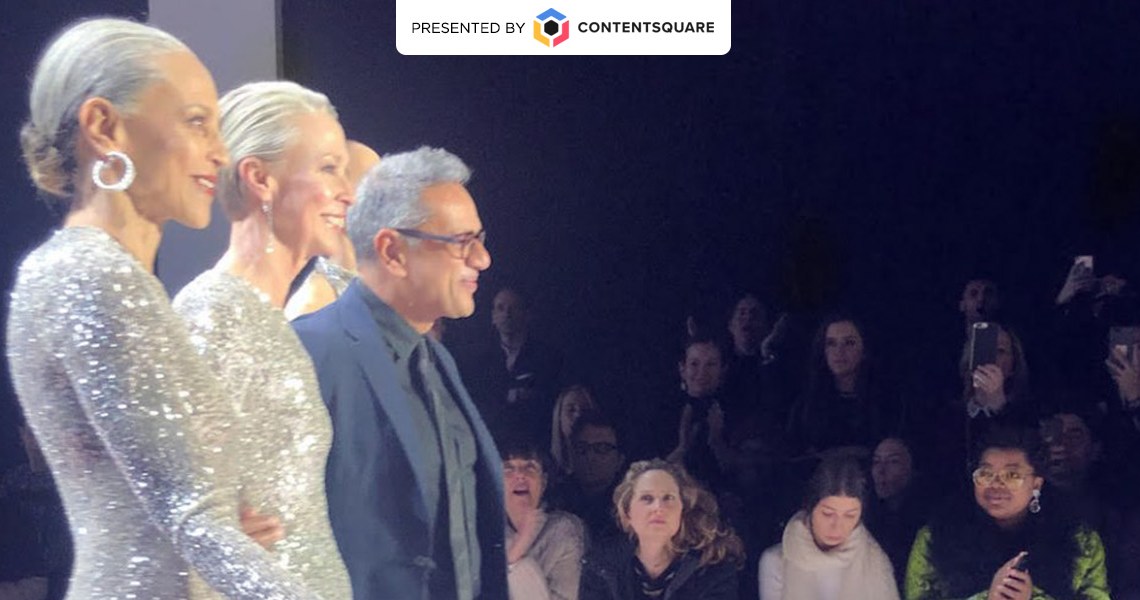Welcome to Glossy’s New York Fashion Week newsletter, bringing you on-the-ground insights and analysis from straight off the runway. All week, we’ll be sending behind-the-scenes glimpses and interviews with industry members straight to your inbox. Sponsored by ContentSquare.
On the most unpleasant day of NYFW — thanks to an ongoing wintry mix — glamour was on full display. It was overt, like Sally LaPointe’s fox fur shawls and faux leather jumpsuits, but also subtle. Think: Vaquera’s boyish 1920s dress emblazoned with a diamond ring pin.
Designer Naeem Khan invited ’70s models Pat Cleveland, Karen Bjornson and Alva Chinn (designer Roy Halston’s original Halstonettes) to evoke the mood. “It’s about Halston, but also giving women choice and chances, given the political environment,” said Khan, who is best known for his gowns but presented a bevy of separates, including suit pants. “Women can wear what they want and when and how. It didn’t use to be that way.”
But choice was not just for women. Vaquera showed masculine and feminine looks on models, 10 (according to my count) of which were men. Men also walked the runway at Christian Cowan, including one who wore a sequin fanny pack and matching sneakers with a streetwear logo T-shirt. “I really wanted to capture the level of glamour and excess that you saw in icons like Joan Crawford and Carol Channing, but with a social media-forward approach, fusing their world and ours. The culture of showing extravagance is greater than ever,” he said.
As for whether the clothes will resonate with customers, Cowan has an equally social media-forward approach for consumers who couldn’t be at the show itself.
“I’ll look at our analytics immediately after the show and see who, when, where and for how long people looked at different pieces,” he explained. “We can then create tailor-made content responding to what our consumers globally want to see. This directly impacts my collections. I want to listen to what our customers are responding to.”
Cowan will have a second go-around to cull customer data on March 8 in Los Angeles. He will be presenting another fashion show devoted to the Powerpuff Girls, who are celebrating their 20th year anniversary. Khan, too, will be headed to L.A. in March as the headliner for L.A. Fashion Week, which begins March 22.
“L.A. Fashion Week is becoming more and more important and relevant,” said Khan. “They asked me to be a part of it, and our customer is everywhere. Why not come to where she is? You really have to be constantly thinking of more than one place or one customer.”
With the European collections taking charge later this week and L.A. making a play for American dominance, it’s almost as if New York Fashion Week didn’t happen.
3 Questions With Designer Mara Hoffman
Since committing yourself to becoming a fully sustainable fashion house in 2015, you’ve fluctuated between shows, presentations and not showing at all during NYFW. Why did you not formally present an outward-facing collection for fall?
I play by my own rules. For spring, I did a live presentation with models, but I felt really driven to do it. When it comes down to it, I’m someone who wants to create and put beautiful things in the world. But for fall, I didn’t feel like I needed to do something again. I felt satiated by what I had done for spring and didn’t want to use that budget and take it away from other things that we are working towards. It comes down to finances, but also intentions. I don’t want to show up every season on a fashion show level because I’m afraid I’m going to disappear.
The fall collection you showed to editors included several more plus-size looks. How is that revamp of sizing progressing?
We knew that having an enormous amount of people feel excluded from our work was not a path we wanted to be on. Inclusivity and the expansion of our size range brings more women in — to be able to shop more responsibly and be a part of a movement that they’ve been left out of. For fall, we offer about 30 percent of our clothes in extended sizing. You think it could be a quicker process, but we are an independently run company and financially, it can be challenging because we haven’t added to our team. We know we can’t grade to a size 20 from a 4 and that you have to start the pattern-making again at a 16. It is a cost. Our growth does take longer, but we want to do it in the best possible way we can.
More brands have embraced sustainability for fall 2019, like Collina Strada. How do you try to serve as a model to those designers?
A big thing for us is that we try to show that you don’t have to start with a sustainable ethos from the beginning and that you can make changes at any point. Now, we are getting honored for our work by Unifi, and we didn’t have to close the business to start over four years ago. We made changes from where we were and made shifts to use more sustainable fabrics. We try to be level-headed about it all and understand that when you are deep in this kind of work, you’re never done with the work — you never get to a place where you are like, “You’re sustainable.” There isn’t an end.
OVERHEARD
“The drilling is making my head hurt.”
“Well, the lights are making me sweat.”
— Vaquera showgoers at Ukrainian East Village discussing the show’s unusual playlist and extreme lighting
This article is part of our series on New York Fashion Week. For more NYFW coverage delivered daily to your inbox, subscribe to our newsletter.




